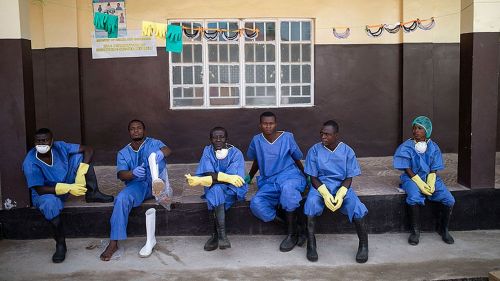Fragile States and Pandemics: Why Preparedness Cannot Happen in a Vacuum

Pandemic preparedness cannot happen in a vacuum. It must include more than research, vaccine development, and the stockpiling of supplies.
The Ebola pandemic
By the end of the Ebola pandemic of 2014-2016, the hemorrhagic virus had spread to 10 countries on three continents, infected nearly 30,000 people, and claimed more than 11,000 lives. Underdeveloped and overstressed public health systems in West Africa were supported by aid and medical personnel from developed and developing countries alike, all eager for transmissions to be contained before they slipped further across borders. The outpouring of support and funds was critical to saving lives and stopping the pandemic altogether.
But today, the second largest Ebola outbreak in history is raging on in the Democratic Republic of the Congo and international response has been comparatively quiet. Given the DRC’s recent historical similarities to Sierra Leone, the country that suffered the most cases and deaths during the 2014 outbreak, it is imperative that the world take notice and provide a rapid and holistic response.
Civil War and Sierra Leone’s Health System
Arguably one of the most devastating long-term casualties of Sierra Leone’s brutal civil war was the decimation of the country’s small health system. Just over a decade after the war’s 2002 official ceasefire, the political, economic, and social fabrics of the country were settling back into place. But the health system, left with just two physicians for every 100,000 patients in 2010, was nearly defenseless to Ebola. That’s the same as the entire population of Chicago relying on just 55 doctors. The outbreak would ultimately infect 14,124 people and kill 3,956 in Sierra Leone alone.
With only one university established before the civil war began in 1991, few Sierra Leoneans held a university degree or medical license, and the destruction of infrastructure during the war made the attainment of a degree extra challenging. Practicing medicine in a post-conflict zone also offered little cost-benefit compared to lucrative opportunities and a growing network of diaspora communities abroad. The World Bank estimates that by 2000, two in five physicians born in Sierra Leone had emigrated along with nearly half of all nurses. The failure to regrow the country’s pool of skilled medical personnel in the years of reconciliation and recovery was so significant that the death of 12 Sierra Leonean doctors during the 2014 Ebola epidemic constituted a near nine percent loss of the country’s 136 doctors.
The country’s demographic and health ratings were slow to improve after the war as well. In 2013, the year before Ebola, nearly nine in ten households lacked access to electricity, one in five lacked a toilet facility, and six percent of women were projected to die from maternal causes in their reproductive lifetimes. The shaky foundation of the country’s health and overall development was ripe for a massive public health crisis.
History Repeats Itself in the DRC
The Democratic Republic of the Congo is grappling with a similar one-two punch of war and disease. Like Sierra Leone, the DRC spent the turn of the century healing from its own civil war. Larger than the size of Greenland and covered in dense forests and poor road infrastructure, it took the country years to disarm, demobilize, and reintegrate combatants after the 2003 ceasefire, delaying other efforts to rebuild. By 2009, the country had just nine physicians for every 100,000 patients—or, 250 doctors in Chicago terms—reflective of a health system slow to heal. High rates of infant and maternal mortality and low educational attainment contributed to the country’s Human Development Index ranking of 176 of 189 countries, making it one of the least developed countries in the world.
In comparing the countries’ shared post-conflict stories, however, there’s one big difference. Instead of violence preceding Ebola, as it did in Sierra Leone, violence and Ebola are now unfolding together in the DRC. The central African country has not experienced a peaceful transition of power since the 1960s and current distrust of the democratic process under departing president Joseph Kabila is growing hostile. Arsonists last month destroyed an election commission warehouse in Kinshasa and the thousands of voting machines stored inside.
At the same time, Ebola has cropped up again in the DRC with 627 cases and 382 deaths (as of January 9, 2019), exacerbating the political tensions. When news spread of plans to exclude millions of voters living in Ebola-threatened cities during the December 30th vote, violent protests were met with sprays of bullets and tear gas. Rioters even attacked the office for Ebola response, as well as an Ebola isolation center in the city of Beni—quite literally opening the door for mass transmission.
The simultaneous public health and humanitarian emergencies are proving to be a dangerous challenge to health and aid workers tasked with tracking and containing contacts. With fighting and transmissions confirmed near the country’s borders with Uganda and Rwanda, displaced populations are spilling the crisis over international lines. It would take just one infection crossing the border to incite a pandemic.
Pandemic Preparedness Cannot Happen in a Vacuum
The World Health Organization named Ebola one of the greatest priorities for research and development in 2018, meaning that without significant investment, the potential for widespread public health emergencies is high. The good news is that lessons learned from the outbreak in 2014 have been many. Incident reporting and response has been much quicker. The development of experimental vaccines has seen some success thus far, along with experimental drugs to treat those already infected. Additionally, logistical response and supply coordination has been strengthened. In the DRC’s case, the current outbreak is the ninth in the country’s history. Each new outbreak provides an opportunity to identify gaps and develop innovative life-saving solutions, and the world’s researchers have stepped up to the challenge.
Yet, while we cheer on these medical marvels and the humanitarians who implement them, these efforts are made even more effective when political, social, and health systems are strengthened simultaneously. Rapid response to an outbreak of any infectious disease—be it influenza, SARS, or an emerging pathogen—in a country with strong political leadership and efficient public health systems makes the difference between an isolated incident and a global disaster. Unfortunately, US commitments to pandemic preparedness are falling short of global needs, along with investments in global development more generally. With conflict and underdevelopment persisting on nearly every continent, it is in our best collective interest to address instability wherever possible.
If there is anything to learn from recent history, it’s that pandemic preparedness cannot happen in a vacuum. It must include more than research, vaccine development, and the stockpiling of supplies. We must fight political corruption, quell civil unrest, expand educational opportunities, and strengthen public health efforts and healthcare systems to protect our global community from catastrophe.

